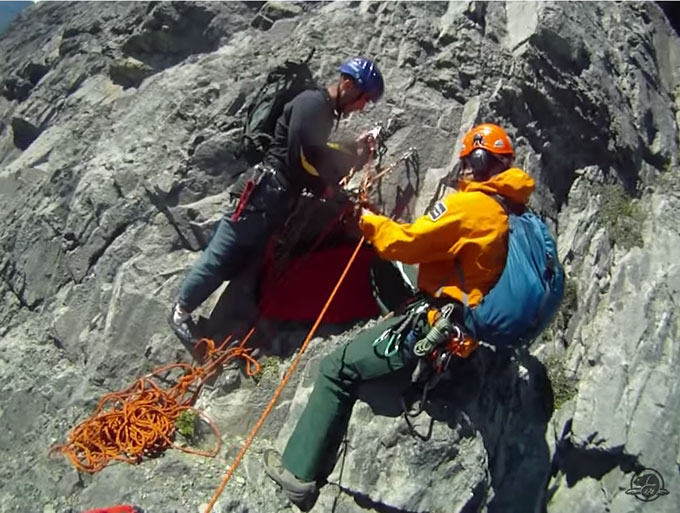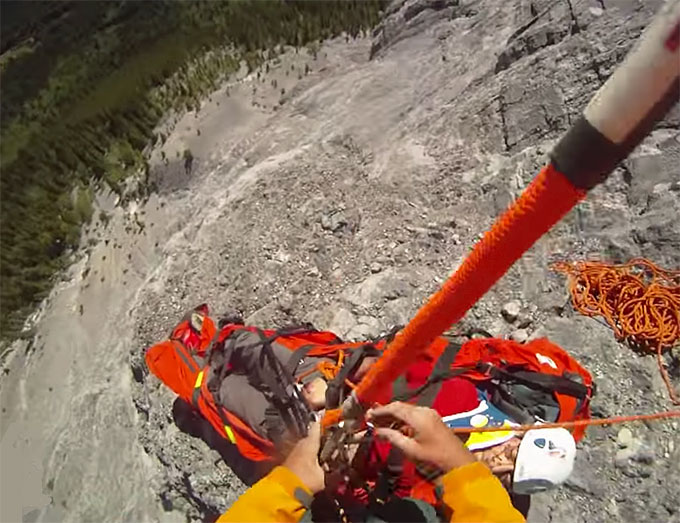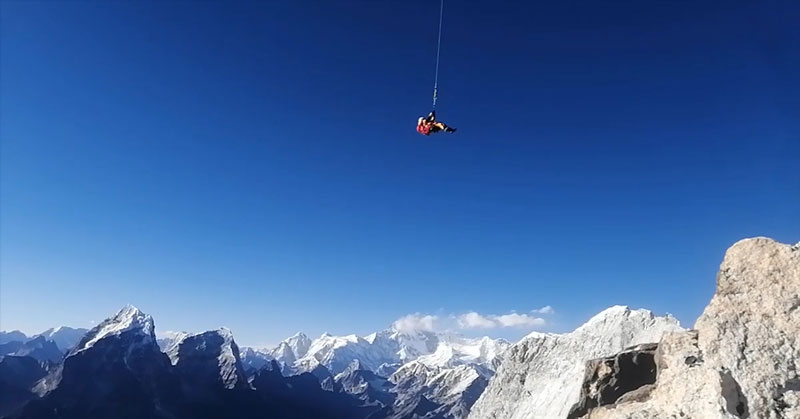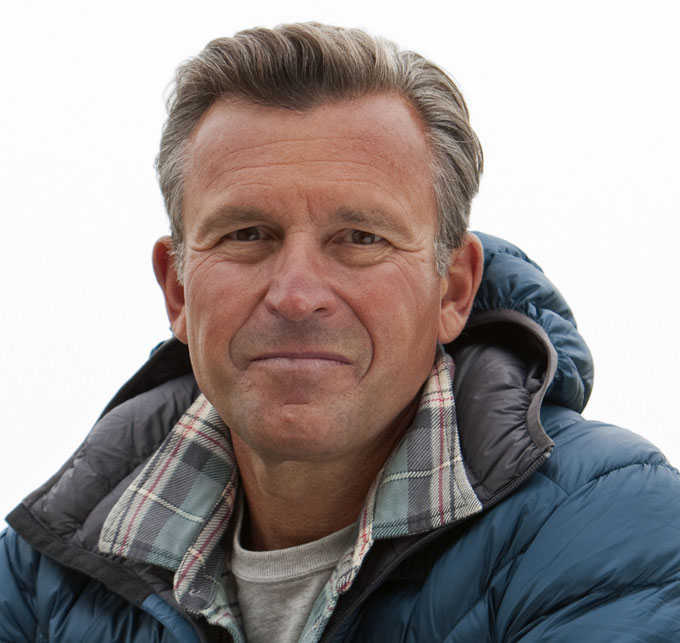
Guest OpEd by Ed Viesturs
The Mount Everest spring climbing season is looming and experts, like Alan Arnette, are predicting record crowds – made up from a mix of mountaineering skill levels – despite the pandemic.
Big crowds and varying skill levels will mean heavy traffic on the tallest mountain in the world – as well as other popular Himalayan mountains.
This combination of factors likely will lead to a higher demand for rescue operations for climbers in distress from altitude sickness, frostbite or any number of other injuries that can occur during an expedition.
Mountaineering above the 6,000 m (nearly 20,000 ft) elevations is risky in its own right. Getting stuck at those altitudes, or higher, can be deadly.
If conditions like the weather, imminent nightfall, exhaustion or limited resources prevent your climbing team from assisting you to safety then your rescue options dwindle.
Sometimes, in addition to all those factors, a climber needs rescue after reaching a section of the mountain that’s challenging due to exposure, high degree pitches or uneven terrain.
At that point one of the only options available is a long line helicopter rescue.
(Long line rescue from Amadablam Camp 2 on Dec 13 2018. Team Capt Bibek Khadka, Rescue specialist Chhiring Denduk Bhote and Ang Tashi Sherpa. Courtesy of Bibek Khadka and YouTube.)
Mingma Sherpa (who goes by Mingma) agrees. He holds the record for a high-altitude, long line rescue.
“There are technical areas of a mountain that make landing a rescue helicopter impossible. In that case, a long line rescue is needed,” he said.
Long lining rescue with helicopters has been utilized for quite some time in areas such as the European alps, but it’s relatively new to Himalayan peaks.
It’s uncertain if climbers might tend to push their limits beyond normal, knowing that this option is available.
The formal name for long line helicopter rescue is Helicopter Flight Rescue System (HFRS) or Helicopter External Transport System – both referring to a helicopter insertion and extraction tool used in rescue missions as well as forest fire fighting and law enforcement operations.
The ability to extend a rescue line, with or without a rescuer attached, allows the helicopter to remain clear of obstacles or avoid landing on uneven, unstable terrain while a rescue is performed.
(Learn about Long Line Rescue Training, during Volo Mission external load training in Campbell, TX. Courtesy of Volo Mission and YouTube.)
There are five key pieces of equipment needed for a long line helicopter rescue system.
-
A belly band is a strap fitted through the cabin of the aircraft, encircling the aircraft structure and providing a secondary point of attachment and release.
-
A Y-lanyard connects the belly band and the aircraft electric release hook to the main load line.
-
The main load line is a high visibility, low-stretch, aeronautically approved rope used to suspend the load under the aircraft.

-
-
For example, one long line rescue rope is “safety yellow” with integrated reflective tracers for visibility.
-
-
-
It’s a 9/16” braid on braid kern-mantle construction with a minimum break strength of 25,500 lbs.
-
-
The rescue harness is the point of attachment for rescuers and rescues to the system.
-
An aerial rescue platform is used to carry an injured patient (if needed).
People often incorrectly assume that the person in the harness at the end of the long line rescue rope is hoisted into the helicopter before flying away.
Mingma was quick to point out that the person dangles at the end of at the end of the long line until a safe landing zone is identified. “We fly to a good place, touchdown, bring the injured climber into the cabin, and then fly to the hospital,” he said.
Depending on the type of helicopter used and the weather conditions, the maximum altitude for rotorcraft rescue operations can vary.
(See this first-hand video footage of Visitor Safety Specialists from Banff /Yoho/Kootenay National Parks conducting a technical helicopter “long-line” rescue. The lead climber of a rock climbing party has taken a 60 foot fall and suffered multiple injuries. They are four pitches up “Dan’s Delight”, a 5.7 rock climb on Cascade Mountain near the town of Banff, Alberta. Courtesy of Parks Canada and YouTube.)
If a distressed climber needs rescue from elevations above a helicopter’s altitude limit then a two-person, pilot and rescuer, hybrid operation gets underway.
The rescuer will use the long line to descend to the ground and then make their way to where the injured climber is to initiate the extraction.
“They drop me at the highest safe altitude for a helicopter and then I climb overnight to the lost or injured climber and bring them down far enough for a helicopter long line extraction the next morning,” Mingma said.
“In Mount Everest, if something happens in Camp 3 we can send rescuers to bring them down to Camp 2 and from there we can load them onto the helicopter and fly them to safety.”
Long line rescue flights can last a few minutes, or longer, depending on the rescue requirements.

Direct flights from the mountain to a hospital take up to 30 minutes, but going from the rescue site to a lower, safer camp or base camp may only take a few minutes.
Mingma said typical flight times are about 15 minutes but he adds that wind and cloud conditions make a difference.
“The pilot may have to re-route his flight path to avoid bad weather,” he said.
Long line rescues are not a guarantee but they are undoubtedly lifesavers.
It’s what Satyarup Siddhanta needed – and likely saved his life – during his Ama Dablam (22,349 ft/ 6,812 m) summit attempt.
“If it was not a timely rescue then I could have been in big, big trouble and perhaps my mountaineering career would have ended,” he said.
(Lorenz can’t make it to a fatally ill climber in time to save him from Everest. Courtesy of Discovery UK and YouTube.)
About the Author
Ed Viesturs is a member of the Global Rescue Mountain Advisory Council and the only American to have climbed all 14 of the world’s 8,000+ meter peaks, and the fifth person to do so without using supplemental oxygen.

He is widely regarded as America’s foremost high-altitude mountaineer. In 1992 he received the American Alpine Club Sowles Award for his participation in two rescues on K2. In 2002, he received the historic Lowell Thomas Award by the Explorer’s Club for outstanding achievement in the field of mountaineering, joining an elite group of climbers including Sir Edmund Hillary.
His achievements as an alpinist include seven summits of Mount Everest.
Viesturs has made a career as a professional mountaineer. He currently does corporate motivational speaking as well, touching on subjects such as Risk Management, Leadership, Teamwork, Overcoming Major Obstacles, and Decision Making Under Pressure.
He is also a brand ambassador for Rolex and continues his long involvement as a design consultant for several prominent outdoor equipment manufacturers.
(Hear from Ed Viesturs directly. He is one of only a handful of climbers in history, and the only American, to reach the summits of all of the world’s 14 8,000-metre (26,000 feet) peaks without supplemental oxygen. In 2005, with his ascent of the 14th summit – Annapurna − one of the world’s most treacherous peaks, Viesturs was awarded National Geographic’s Adventurer of the Year. In all, Viesturs, equipped with an Oyster Perpetual Explorer II, has made 21 ascents of mountains that are more than 8,000 metres (26,000 feet) high, including Mount Everest seven times.
In the community, Ed serves as an advocate for Big City Mountaineers (BCM), an organization that instills critical life skills in under-resourced youth through wilderness mentoring experiences that help kids stay in school, reduce violence and avoid drug use.
He is spokesperson for BCM’s Summit For Someone benefit climb series, which places individuals on iconic peaks to raise support for BCM youth and programs.
Viesturs capped his climbing career by reaching the summits of all fourteen of the world’s 8000-meter peaks without supplemental oxygen, an 18 year project he christened Endeavor 8000. He is one of only a handful of climbers (and the only American) in history to accomplish that feat.
He completed his quest on May 12, 2005 with his ascent of Annapurna, one of the world’s most treacherous peaks. That year National Geographic’s named him Adventurer of the Year.
(Watch some of the most tense helicopter rescues from Mount Everest, as told by the pilots themselves. Courtesy of Discovery UK and YouTube.)
AST strives to meet a 3 STAR trustworthiness rating, based on the following criteria:
- Provides named sources
- Reported by more than one notable outlet
- Includes supporting video, direct statements, or photos

















